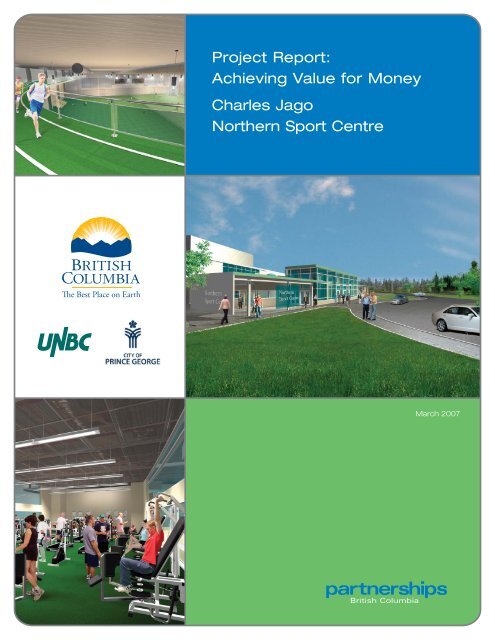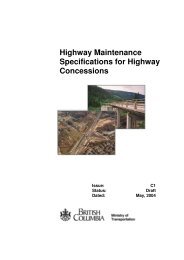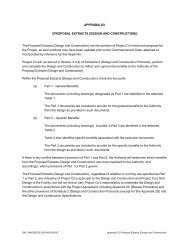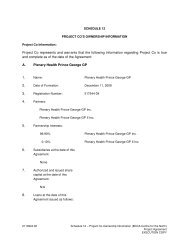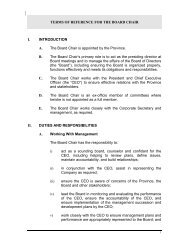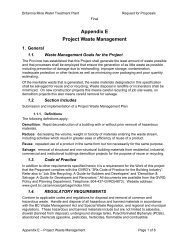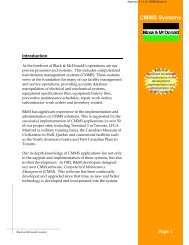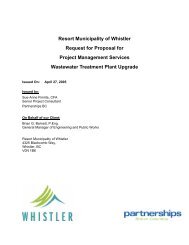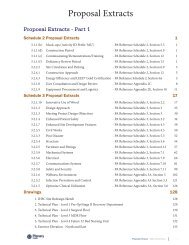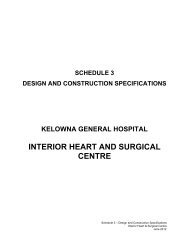Project Report - Partnerships British Columbia
Project Report - Partnerships British Columbia
Project Report - Partnerships British Columbia
Create successful ePaper yourself
Turn your PDF publications into a flip-book with our unique Google optimized e-Paper software.
<strong>Project</strong> <strong>Report</strong>:<br />
Achieving Value for Money<br />
Charles Jago<br />
Northern Sport Centre<br />
March 2007
Table of Contents<br />
Purpose of this Document . . . . . . . . . . . . . . . . . . . . . . . . . . . . . . . . . . . . . . . . . . .i<br />
Executive Summary . . . . . . . . . . . . . . . . . . . . . . . . . . . . . . . . . . . . . . . . . . . . . . .1<br />
1. <strong>Project</strong> Background, Rationale and Objectives . . . . . . . . . . . . . . . . . . . . . . . .3<br />
2. Competitive Selection Process . . . . . . . . . . . . . . . . . . . . . . . . . . . . . . . . . . . . .4<br />
3. Final Agreement . . . . . . . . . . . . . . . . . . . . . . . . . . . . . . . . . . . . . . . . . . . . . . . .7<br />
4. Achieving Value for Money . . . . . . . . . . . . . . . . . . . . . . . . . . . . . . . . . . . . . . . .9
Purpose of this Document<br />
<strong>Partnerships</strong> BC works with its clients to undertake<br />
an analysis of the value for money expected over<br />
the life of the project. Value for money is a broad<br />
term that captures both quantitative factors, such as<br />
costs, and qualitative factors, such as service<br />
quality and public interest.<br />
Value for money is one of six key principles guiding<br />
public sector capital asset management in <strong>British</strong><br />
<strong>Columbia</strong>. The others are:<br />
• sound fiscal and risk management;<br />
• strong accountability in a flexible and<br />
streamlined process;<br />
• emphasis on service delivery;<br />
• serving the public interest; and<br />
• competition and transparency.<br />
Since 2002, these principles have guided the B.C.<br />
public sector’s approach to acquiring and managing<br />
assets such as roads and health care facilities.<br />
Under the Capital Asset Management Framework,<br />
ministries and other public bodies are encouraged<br />
to consider all available options for meeting their<br />
service objectives. They analyze the options and,<br />
after considering the qualitative and quantitative<br />
advantages and disadvantages of each, choose the<br />
one that overall best meets service delivery needs<br />
and makes the best use of taxpayers’ dollars.<br />
In some cases, the best option may be traditional<br />
procurement – where assets are purchased entirely<br />
with taxpayer supported debt and operated<br />
exclusively by the public sector. In other cases,<br />
agencies may find innovative ways to meet their<br />
service needs without acquiring capital assets.<br />
In all cases, agencies are publicly accountable<br />
through regular budgeting, auditing and<br />
reporting processes.<br />
In all of its procurement processes, the Province is<br />
committed to a high standard of public disclosure to<br />
ensure accountability. This report describes the<br />
rationale, objectives and processes that led to the<br />
use of an early partnering process for the Charles<br />
Jago Northern Sport Centre project, giving the<br />
public a clear sense of how and why the decision<br />
was reached to proceed with that option. It explains<br />
how value for money was achieved in the context of<br />
this unique project.<br />
For more on the Province’s Capital Asset<br />
Management Framework, please go to<br />
http://www.fin.gov.bc.ca/tbs/camf.htm<br />
For more on public private partnerships in B.C.,<br />
please go to www.partnershipsbc.ca<br />
i
Executive Summary<br />
<strong>Project</strong> Background<br />
In an effort to realize the full potential of Northern<br />
B.C. arising from the 2010 Olympic and Paralympic<br />
Winter Games, community leaders from the City of<br />
Prince George (the City), the University of Northern<br />
<strong>British</strong> <strong>Columbia</strong> (UNBC), the Spirit of BC Prince<br />
George Community Committee and PacificSport<br />
came together to develop a plan to create a<br />
regional centre of excellence in sport. The resulting<br />
concept, the Charles Jago Northern Sport Centre<br />
(the Centre), is a facility that will bring athletes,<br />
coaches and communities together to foster a<br />
distinctive culture of excellence by integrating sport<br />
and education. The Centre is designed to be a<br />
Nordic Centre of Excellence and provide elite<br />
training opportunities in northern B.C. for winter and<br />
summer sports.<br />
The Centre will be located at the entrance to the<br />
UNBC campus, and includes a gym, indoor track,<br />
and multi-use indoor field. The Centre will be a<br />
facility that complements the existing amenities in<br />
Prince George such as the Northern Medical<br />
Program, high-performance sport and coaching,<br />
and educational opportunities available at UNBC.<br />
The Centre will also have the capacity to support<br />
high-performance athletes and coaches, particularly<br />
in Nordic skiing. The guaranteed maximum price<br />
for the facility is $30.75 million. The B.C.<br />
government is contributing up to $20.5 million in<br />
provincial funding for the Centre.<br />
UNBC and the City created a<br />
corporation, Northern Sport Centre<br />
Limited (NSCL), to oversee the<br />
development of the new Centre.<br />
This partnership reflects both the<br />
commitment to and the importance<br />
of the project for the City, UNBC and<br />
the Province. <strong>Partnerships</strong> BC was<br />
retained by NSCL to provide<br />
business and procurement<br />
advisory services for the project.<br />
Competitive Selection Process<br />
There are a number of procurement models to<br />
consider when evaluating which model will have the<br />
potential to deliver best value for money. Value for<br />
money is defined as meeting or exceeding project<br />
objectives for the best cost. One of the most<br />
important determinants of value for money is the<br />
ability to transfer project risks, such as construction<br />
schedule and budget, to the party best able to<br />
manage those risks.<br />
Three possible procurement options include:<br />
• Traditional delivery – this option involves separate<br />
procurements for the design phase and the build<br />
phase in a linear process, often called Design-<br />
Bid-Build (DBB).<br />
• Design-Build (DB) – this option involves<br />
developing one procurement process for both the<br />
design and build portion of the project.<br />
• Design-Build-Finance-Operate (DBFO) – this<br />
option involves one overall procurement process<br />
for the design, building, operation and financing<br />
of the project.<br />
Initially, the procurement process selected for this<br />
project was the DBFO model. A market sounding<br />
process was undertaken to ask market participants<br />
their views and assess responsiveness towards a<br />
flexible approach to consider different options for<br />
the project. As the procurement process unfolded,<br />
Artist rendering of the gymnasium<br />
1 <strong>Project</strong> <strong>Report</strong>: Achieving Value for Money – Charles Jago Northern Sport Centre
it was determined that a DB model was more<br />
appropriate for this particular project.<br />
The DB partnership agreement was achieved<br />
through an early partnering process that enabled<br />
the project and proponent teams to work<br />
collaboratively to determine the final scope and<br />
design of the project, programming options,<br />
variations and cost implications, output based<br />
specifications and the performance requirements.<br />
This process provided for maximum flexibility and<br />
innovation, while maintaining strong competitive<br />
tension and transparency throughout.<br />
There are a number of features unique to this project<br />
that supports the DB model versus the DBFO model.<br />
For example, the Centre will operate as an elite,<br />
Nordic sports training centre and it would have been<br />
difficult to find experienced operators due to the<br />
unique nature of the facility. In addition, the market<br />
sounding process suggested that although the<br />
DBFO model was favoured, the potential for additional<br />
revenue sources from programming opportunities at<br />
the Centre was considered a risk and therefore less<br />
attractive from an operator’s perspective.<br />
Final Agreement<br />
The final DB partnership agreement between UNBC<br />
and Giffels Design Build Inc. is an agreement for the<br />
design and construction of the Centre at a guaranteed<br />
maximum price of $29 million (capital cost). The<br />
facility is expected to open in September 2007.<br />
Giffels Design Build Inc. is leading a consortium of<br />
private companies that have partnered with UNBC<br />
and the City on the project. The Northern Sport<br />
Centre Consortium (NSCC) is comprised of the<br />
following companies: Giffels Design Build Inc.,<br />
NORR Ltd., Chernoff Thompson Architects and<br />
Western Industrial Contractors of Prince George.<br />
Benefits to Taxpayers<br />
The DB partnership agreement between NSCL and<br />
NSCC achieves a number of benefits for taxpayers,<br />
including:<br />
• A guaranteed maximum price of $30.75 million for<br />
design and construction of the facility, procurement<br />
and project management costs.<br />
• Through design innovation and the early<br />
partnering process, an increase in scope from<br />
the original concept of the facility at no extra<br />
capital cost.<br />
• A long-term community commitment to the<br />
operation of the Centre.<br />
2
1. <strong>Project</strong> Background, Rationale and Objectives<br />
Charles Jago<br />
Northern Sport Centre: Background<br />
Community leaders and sport user groups from the<br />
City of Prince George (the City), Northern B.C., and<br />
the University of Northern <strong>British</strong> <strong>Columbia</strong> (UNBC)<br />
developed a plan on how Prince George and the<br />
North could realize their full potential arising from<br />
the 2010 Olympic and Paralympic Winter Games in<br />
<strong>British</strong> <strong>Columbia</strong>. The resulting concept, the<br />
Charles Jago Northern Sport Centre (the Centre), is<br />
a facility that will bring together athletes, coaches,<br />
and communities to foster a distinctive culture of<br />
excellence by integrating sport and education.<br />
The key objectives of the Centre are to:<br />
• Establish a regional centre that will attract and<br />
assist in retaining students and athletes in the<br />
North.<br />
• Provide a significant economic stimulus for the<br />
City and Northern B.C. through future sport<br />
hosting opportunities.<br />
It is expected that the Centre, through its location<br />
on the UNBC campus and planned programming,<br />
will strengthen Prince George’s role as a postsecondary<br />
education centre and provide<br />
opportunities for citizens of the North to pursue<br />
sport and education in their home region. The<br />
Centre is expected to contribute to the growth and<br />
development of Prince George and the surrounding<br />
region by supporting sport tourism and providing a<br />
lasting legacy to the 2010 Olympic and Paralympic<br />
Winter Games.<br />
The initial phase of the Centre will encompass<br />
approximately 12,500 square metres of indoor<br />
space that includes:<br />
• A three-court gymnasium with seating for 2,000.<br />
• Two indoor fields.<br />
• An elevated 280-metre indoor track.<br />
• An expanded fitness centre.<br />
• Two squash courts.<br />
• Ten offices for coaches.<br />
• A seminar room for coaching clinics.<br />
• Physiotherapy and strength training facilities.<br />
• Connection to the trail network on Cranbrook Hill.<br />
• Additional exterior space for a sports field and<br />
parking.<br />
UNBC and the City created a corporation, Northern<br />
Sport Centre Limited (NSCL), to oversee the<br />
development of the new Centre.<br />
<strong>Project</strong> Objectives<br />
The vision of the project is a facility that improves the<br />
regional and community (including UNBC) sport and<br />
recreation delivery system. It is expected that the<br />
project will:<br />
• Provide a sport and recreational facility for the City<br />
and UNBC that provides equivalent athletic and<br />
recreational opportunities to those offered in other<br />
communities.<br />
• Develop into a regional centre of sports<br />
excellence that will attract and assist in retaining<br />
students and athletes in the North.<br />
• Promote the integration of education, health, sport<br />
and wellness for the North.<br />
• Enhance existing competitive and recreational<br />
sport facilities in the City.<br />
In fulfilling this vision, the Centre will meet the<br />
following objectives:<br />
• Address regional and university needs for<br />
competitive sport, recreational and wellness<br />
programs through the provision of a broad range<br />
of opportunities, programs, and services.<br />
• Provide a focal point for the growth and<br />
development of local and regional sports<br />
communities, including athletes, parents,<br />
coaches, and officials.<br />
• Support the ongoing development of Nordic<br />
sports through the development of a Nordic<br />
Sports Centre of Excellence.<br />
3 <strong>Project</strong> <strong>Report</strong>: Achieving Value for Money – Charles Jago Northern Sport Centre
2. Competitive Selection Process<br />
The procurement process for the Charles Jago<br />
Northern Sport Centre evolved from Design-<br />
Build-Finance-Operate to a Design-Build<br />
partnership agreement based on the unique<br />
features and requirements of the facility.<br />
Competitive Selection Process<br />
Objectives<br />
The project team was guided by the following<br />
objectives throughout the competitive selection<br />
process:<br />
• Design and construct the project effectively within<br />
the affordability cap identified by the feasibility study.<br />
• Provide UNBC and the City with price certainty<br />
during the design and construction phase of<br />
the project.<br />
• Optimize the risk allocation between the parties in<br />
order to provide value for money.<br />
• Ensure access to innovation and flexibility.<br />
• Optimize functional programming.<br />
• Deliver customer service.<br />
• Enable flexibility for expansion.<br />
• Ensure a fair, open and transparent procurement<br />
process.<br />
Initial Approach<br />
A two-stage procurement process was initially<br />
chosen to select a private sector partner to design,<br />
build, finance, and operate the new facility. This<br />
process includes a Request for Qualifications (RFQ),<br />
to allow all interested respondent teams to submit<br />
their qualifications and experience for evaluation,<br />
and a Request for Proposal (RFP), in which the<br />
proponents submit detailed technical and financial<br />
proposals. Following an evaluation of the proposals<br />
and the selection of a single preferred proponent,<br />
final negotiations commence to reach a final<br />
agreement.<br />
Market Sounding Process<br />
A market sounding process was undertaken to test<br />
the market and assess responsiveness towards a<br />
flexible approach to consider different options for<br />
the project. After receiving approval from NSCL,<br />
<strong>Partnerships</strong> BC conducted a market sounding on the<br />
Centre business structure and procurement model.<br />
The market sounding process was conducted in a<br />
fair and transparent manner. This included the<br />
public availability of materials, local advertising<br />
within Prince George, as well as direct communication<br />
with known market participants in this type of project.<br />
Market Sounding Responses<br />
The following responses were identified regarding<br />
which approach would be best suited to this project:<br />
• The market sounding indicated a preference for a<br />
DBFO approach, but concerns were raised about<br />
the allocation of some key risks.<br />
• The operating risks related to generating revenue<br />
and programming to the private sector were<br />
fundamental to the success of the project.<br />
• Concern was expressed by some companies that<br />
it could be difficult to find experienced operators<br />
due to the unique nature of the proposed facility.<br />
• All companies had concerns related to the<br />
schedule, particularly the ability to get community<br />
consensus on the design.<br />
• Concerns were raised regarding the current state<br />
of the B.C. construction market which was<br />
experiencing rapidly increasing cost pressures<br />
creating a great deal of uncertainty.<br />
4
The following specific issues were identified related<br />
to the unique nature of this project:<br />
• The revenue risk was significant and it was not<br />
clear what the additional programming<br />
opportunities and sources of revenue might be.<br />
• The scope of the project would have been difficult<br />
to define during the procurement process,<br />
particularly with regards to programming and<br />
revenue responsibilities, and the technical<br />
specifications. This would pose difficulties in<br />
defining performance specifications in an RFP<br />
format.<br />
• There was a significant need for input from<br />
stakeholders during the project scoping and<br />
development of proposals for the project. Again,<br />
this would pose challenges for the RFP approach.<br />
• The City and UNBC were willing to accept twothirds<br />
of the programming risk and wished to<br />
transfer one-third to the private sector operator.<br />
The response from the market indicated that<br />
although it was feasible to transfer that risk, it<br />
would be a challenge.<br />
The market sounding process confirmed that the<br />
DBFO model was the favoured approach and the<br />
procurement process should proceed with a RFQ.<br />
This would allow flexibility for the market to respond<br />
with its qualifications to implement a DBFO model.<br />
However, it was also recommended that an early<br />
partnering or strategic partnering procurement<br />
model should be considered as an alternative to the<br />
RFP stage, depending on the assessment of the<br />
responses to the RFQ. Both strategic and early<br />
partnering are competitive processes designed to<br />
solicit high quality partners who can provide<br />
innovative solutions for achieving desired objectives,<br />
rather than collecting proposals to provide a<br />
specified solution or outcome. This approach is<br />
particularly useful where the public sector is seeking<br />
innovative solutions from the private sector and the<br />
process better enables the opportunity to leverage<br />
private sector expertise earlier in the process.<br />
RFQ Process and Evaluation<br />
A Fairness Auditor and Conflict of Interest<br />
Adjudicator were engaged to ensure a fair, open<br />
and transparent procurement process.<br />
On July 13, 2005 the project team hosted an<br />
information meeting at UNBC for the prospective<br />
respondents. Respondents were advised that two<br />
options would be considered to replace the<br />
standard RFP phase of the project. These options<br />
were: proceed to negotiate with two potential<br />
partners (strategic partnering); proceed to negotiate<br />
with one partner (early partnering).<br />
On August 5, 2005, four submissions were received<br />
in response to the RFQ. A number of internal staff<br />
and external expert advisors were assembled for the<br />
purpose of evaluating the submissions. An executive<br />
committee, comprised of senior officials from the<br />
City, UNBC and Pacific Sport, was responsible for<br />
evaluating and scoring the various proposals.<br />
A Fairness Auditor, Joan M. Young, and Conflict of<br />
Interest Adjudicator, Leslie Peterson, Q.C., were<br />
engaged to ensure a fair, open and transparent<br />
process. The Fairness Auditor provided an<br />
independent opinion as to the fairness of the<br />
procedures that were followed and as to whether the<br />
requirements of the process as defined in the RFQ<br />
were met. In her report, the Fairness Auditor<br />
reported the following:<br />
“The overall procurement process associated<br />
with the RFQ for the Northern Sport Centre<br />
<strong>Project</strong> has been conducted in a fair manner<br />
and in accordance with the procedures<br />
established in the Request for Qualifications<br />
stage.”<br />
After a complete and thorough evaluation of all<br />
respondents, including presentations from the two<br />
leading respondents, it became clear that a single<br />
respondent – the Northern Sport Centre Consortium<br />
(NSCC) – was significantly superior to the other<br />
three respondents, particularly with respect to: local<br />
knowledge, experience of the team, understanding<br />
of the project challenges, and the overall quality of<br />
the submission.<br />
5 <strong>Project</strong> <strong>Report</strong>: Achieving Value for Money – Charles Jago Northern Sport Centre
Consequently, the executive committee<br />
recommended to the NSCL Board of Directors that<br />
NSCC be chosen as the preferred proponent, and to<br />
proceed with an early partnering approach.<br />
Rationale for Choosing Early<br />
Partnering<br />
NSCL made the decision to replace the standard<br />
RFP phase of the project with early partnering<br />
based on the following considerations:<br />
• Responses from market sounding indicated that<br />
without clearly defined programming requirements<br />
it would be difficult to run an RFP process.<br />
• Early partnering would allow an interactive<br />
process where owners, designers, builders and<br />
operators define programming needs within a<br />
budgetary cap.<br />
• NSCL consulted with proponents and received<br />
unanimous support to proceed with early partnering.<br />
• The decision to proceed with early partnering was<br />
supported by the Fairness Auditor.<br />
Results of Early Partnering<br />
The early partnering process allowed the NSCL<br />
project team to enter into negotiations with the<br />
proponent. NSCL and the proponent were then able<br />
to work together to determine the final scope and<br />
design of the project, programming options,<br />
variations and cost implications, output based<br />
specifications and the performance requirements.<br />
In addition, they were also able to negotiate a<br />
project agreement satisfactory to both parties.<br />
Throughout this process it became clear that this<br />
particular project would more appropriately be<br />
delivered through a DB partnership agreement.<br />
Following discussions with the operations team from<br />
the proponent, it was agreed that the operations<br />
should be undertaken by NSCL, due to the unique<br />
nature of the facility.<br />
Procurement Timetable<br />
Procurement Milestone Date<br />
Issue Request for Qualification (RFQ) June 29, 2005<br />
Information Meeting and Site Visit July 13, 2005<br />
Closing Date for Submissions August 5, 2005<br />
(revised date)<br />
Notice of Short-Listed Proponents September 2005<br />
Signing of Agreement April 2006<br />
Facility Operational Summer 2007<br />
Contract Finalization<br />
Following the selection of NSCC as the preferred<br />
proponent in September 2005, the project team<br />
undertook intensive negotiations to finalize contract<br />
details and finalized a contract in April 2006.<br />
Competitive Selection Costs<br />
The total procurement costs incurred by NSCL from<br />
the date of issuance of the RFQ until financial close<br />
are approximately $850,000. This represents<br />
approximately three per cent of the total<br />
construction cost for the Centre.<br />
6
3. Final Agreement<br />
The DB partnership agreement between the<br />
University of Northern BC and Giffels Design<br />
Build Inc. is a legal agreement for the construction<br />
of the Charles Jago Northern Sport Centre at a<br />
guaranteed maximum price of $29,000,000.<br />
UNBC and Giffels Design Build Inc. have agreed<br />
that the design-builder will design, construct and<br />
commission the project for the owner in accordance<br />
with the terms and conditions of the agreement.<br />
Giffels Design Build Inc. will perform and provide all<br />
design, labour, services and other acts, and provide<br />
all supplies, materials, construction equipment and<br />
machinery required for performance of the work.<br />
UNBC will pay a guaranteed maximum price of $29<br />
million to Giffels Design Build Inc., as the complete<br />
and total payment for satisfactory performance of<br />
the work.<br />
Giffels Design Build Inc. is leading a consortium of<br />
private companies that have partnered with UNBC<br />
and the City on the project. The NSCC is<br />
comprised of the following companies:<br />
• Giffels Design Build Inc. is the largest turnkey<br />
provider of sporting facilities in Canada.<br />
• NORR Ltd. is a well-established architectural and<br />
engineering firm that has designed or<br />
reconfigured more than 25 sporting facilities<br />
across Canada.<br />
• Chernoff Thompson Architects is a B.C.-based<br />
architecture firm with an office in Prince George.<br />
It has extensive experience with UNBC, including<br />
serving as the architect for the Teaching<br />
Laboratory and the Bentley Centre.<br />
• Western Industrial Contractors of Prince George<br />
is one of the largest general contractors in <strong>British</strong><br />
<strong>Columbia</strong> and is based in Prince George.<br />
UNBC, on behalf of NSCL, will monitor the contract<br />
during the construction phase.<br />
Financing<br />
The financing for the project is provided by the<br />
Province of B.C., UNBC and the City.<br />
On April 14, 2005, the B.C. Ministry of Small Business<br />
and Economic Development announced that the<br />
Province would provide a grant of up to $20.5 million<br />
to UNBC for the Centre. Both UNBC and the City<br />
committed to contribute $5.125 million each to the<br />
design and construction of the Centre. Both UNBC<br />
and the City will be jointly responsible for the costs<br />
associated with operating and maintaining the Centre.<br />
Risk Allocation Summary<br />
<strong>Project</strong> risks were negotiated and allocated to<br />
the party best able to cost-effectively manage<br />
those risks.<br />
Giffels Design Build Inc. assumes the majority of the<br />
risks relating to construction cost overruns in this<br />
project, protecting B.C. taxpayers from these<br />
potential costs. The early partnering process<br />
proved effective in transferring risk to the private<br />
partner in this agreement. Under the contract,<br />
Giffels Design Build Inc. is primarily responsible for<br />
the risks associated with the following:<br />
• Construction costs, including any cost overruns,<br />
and labour.<br />
• Geotechnical conditions and site clearing.<br />
• Commissioning.<br />
• Development and design.<br />
• Quality assurance and quality control.<br />
7 <strong>Project</strong> <strong>Report</strong>: Achieving Value for Money – Charles Jago Northern Sport Centre
The table below shows which risks rest with which party. Shared risks are indicated by check marks under<br />
both parties.<br />
Risk UNBC Giffels<br />
Site and Land Risks<br />
Site Availability at UNBC Campus ✓<br />
Acquisition of Site ✓<br />
Cleanup of existing environmental<br />
contamination of Site ✓<br />
Site Geotechnical Conditions ✓<br />
Demolition, site clearing, and<br />
diversion / relocation / extension<br />
of Utilities ✓<br />
Development Design<br />
Planning and Development of Site ✓<br />
Design of Charles Jago<br />
Northern Sport Centre ✓<br />
Design Error ✓<br />
Changed Conditions ✓<br />
Patent Infringement ✓<br />
Development Construction<br />
Building Permits ✓<br />
Construction of Facilities ✓<br />
Commissioning of Facilities ✓<br />
Occupancy Permissions ✓<br />
Quality Management ✓<br />
Construction Cost Overruns ✓<br />
Insurance ✓<br />
Bonding by Developer ✓<br />
Financing During Construction,<br />
as needed ✓<br />
Quality Monitoring and Audit ✓ ✓<br />
Risk UNBC Giffels<br />
Administrative or Miscellaneous<br />
Feasibility of <strong>Project</strong>,<br />
physical and financial ✓<br />
Developer insolvency ✓<br />
UNBC-initiated Change Orders ✓<br />
Labour ✓<br />
Delays by UNBC ✓<br />
Force Majeure<br />
Development and Implementation<br />
✓ ✓<br />
of Public Communication Strategy ✓ ✓<br />
Site / Construction<br />
Weather ✓<br />
Fire ✓<br />
Vandalism ✓<br />
Damage to Works ✓<br />
Damage / Injury to Third Party ✓<br />
Defective Works / Materials ✓<br />
Quality Assurance / Quality Control ✓<br />
Workers’ Safety Insurance Board ✓<br />
Fair Wage Compliance ✓<br />
Site Monitoring and Inspections ✓ ✓<br />
8
4. Achieving Value for Money<br />
The procurement process for the Centre can best<br />
be described as an evolution from the DBFO model<br />
to the DB model based on the unique features and<br />
requirements of the facility. The early partnering<br />
process provided for maximum flexibility and<br />
innovation, while maintaining a strong competitive<br />
tension and transparency throughout. The ability for<br />
experts on both the proponent and project teams to<br />
interact and create synergies allowed for the optimal<br />
solution to emerge while staying within the stated<br />
capital budget.<br />
The final DB partnership agreement provides<br />
taxpayers with the following benefits:<br />
• Protected from cost overruns: the final<br />
agreement achieves an allocation of project risks<br />
that is expected to protect taxpayers from cost<br />
overruns or schedule delays. Within the context<br />
of a provincial construction market characterized<br />
by increasing cost pressures, the Centre will be<br />
constructed for a guaranteed maximum price as<br />
stipulated at the outset of the process.<br />
• Expanded facility: design innovation and<br />
significant interactions between the project and<br />
proponent teams through the early partnering<br />
process resulted in an increase in scope from the<br />
original concept of the facility at no extra capital<br />
cost. Moreover, the facility will be constructed<br />
with a commitment to high performance sport<br />
specifications and standards.<br />
• Long term relationships: this project brought<br />
together two public agencies, UNBC and the City,<br />
and strengthened their relationship through the<br />
formation of the NSCL to protect the interests of<br />
the citizens of Prince George and area over the<br />
long term.<br />
The Centre will benefit the whole community of<br />
Prince George and area by creating new<br />
opportunities for local athletes as well as attracting<br />
top-tier athletes and students from around the world.<br />
Computer generated rendering of<br />
the sport medicine facility.<br />
9 <strong>Project</strong> <strong>Report</strong>: Achieving Value for Money – Charles Jago Northern Sport Centre


